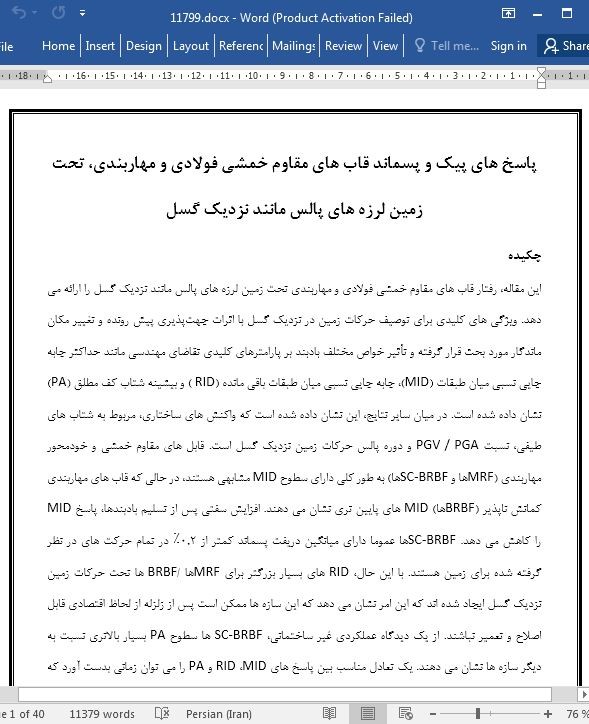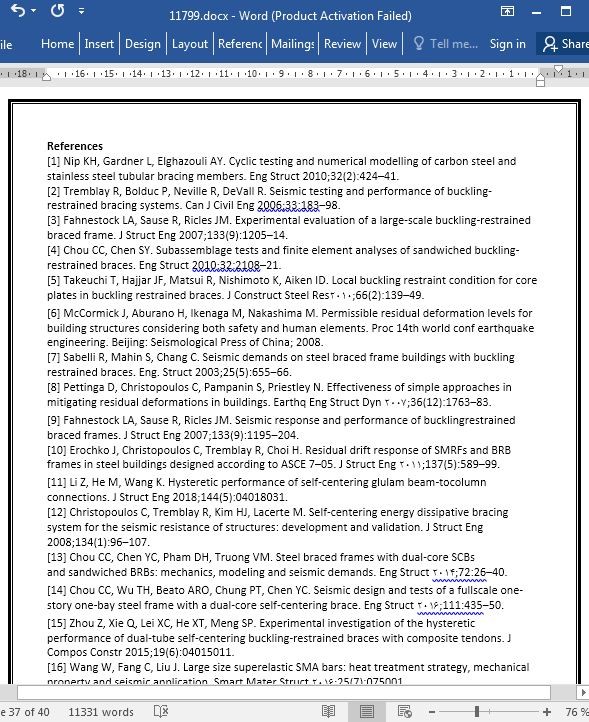
پاسخ های پیک و پسماند قاب های مقاوم خمشی فولادی و مهاربندی، تحت زمین لرزه های پالس مانند نزدیک گسل
چکیده
این مقاله، رفتار قاب های مقاوم خمشی فولادی و مهاربندی تحت زمین لرزه های پالس مانند نزدیک گسل را ارائه می دهد. ویژگی های کلیدی برای توصیف حرکات زمین در نزدیک گسل با اثرات جهتپذیری پیش رونده و تغییر مکان ماندگار مورد بحث قرار گرفته و تأثیر خواص مختلف بادبند بر پارامترهای کلیدی تقاضای مهندسی مانند حداکثر جابه جایی نسبی میان طبقات (MID)، جابه جایی نسبی میان طبقات باقی مانده (RID ) و بیشینه شتاب کف مطلق (PA) نشان داده شده است. در میان سایر نتایج، این نشان داده شده است که واکنش های ساختاری، مربوط به شتاب های طیفی، نسبت PGV / PGA و دوره پالس حرکات زمین نزدیک گسل است. قابل های مقاوم خمشی و خودمحور مهاربندی (MRFها و SC-BRBFها) به طور کلی دارای سطوح MID مشابهی هستند، در حالی که قاب های مهاربندی کمانش ناپذیر (BRBFها) MID های پایین تری نشان می دهند. افزایش سفتی پس از تسلیم بادبندها، پاسخ MID را کاهش می دهد. SC-BRBFها عموما دارای میانگین دریفت پسماند کمتر از 0.2٪ در تمام حرکت های در نظر گرفته شده برای زمین هستند. با این حال، RID های بسیار بزرگتر برای MRFها / BRBFها تحت حرکات زمین نزدیک گسل ایجاد شده اند که این امر نشان می دهد که این سازه ها ممکن است پس از زلزله از لحاظ اقتصادی قابل اصلاح و تعمیر نباشند. از یک دیدگاه عملکردی غیر ساختمانی، SC-BRBF ها سطوح PA بسیار بالاتری نسبت به دیگر سازه ها نشان می دهند. یک تعادل مناسب بین پاسخ های MID، RID و PA را می توان زمانی بدست آورد که از SC-BRBهای "جزئی" استفاده شود. برای تسهیل طراحی مبتنی بر عملکرد، مدل های پیش بینی RID در نهایت پیشنهاد کردند که کدام یک قادر به ارزیابی موثر ارتباط بین MID و RID است.
1. مقدمه
قاب هاي مقاوم خمشی فولادی (MRFهایی) که مطابق با کد های مدرن طراحی شده اند، به صورت پیش فرض دارای شکل پذیری رضایت بخش، ظرفیت اتلاف انرژی و مقاومت فروریختگی در برابر زلزله های شدید می باشند. قاب های مهاربندی فولادی همچنین یک دسته غالب از سیستم های ساختمانی باربری جانبی هستند، اگر چه بادبند های فولادی معمولی مستعد کمانش کلی و محلی تحت فشار هستند که قابلیت اتلاف انرژی آن ها را به خطر می اندازد [1]. از طرف دیگر، مهاربند های کمانش ناپذیر (BRBها) دارای رفتار هیسترتیک بالا تحت بارگذاری چرخه ای هستند و توجه زیادی را در میان محققان و شاغلان حوزه لرزه ای به خود اختصاص داده اند [2-5].
6. خلاصه و نتیجه گیری
این مقاله بر روی رفتار دینامیک کلی MRFها، BRBFها و SC-BRBFهای در معرض زمین لرزه های پالس مانند نزدیک گسل متمرکز است. پاسخ های ساختاری به حرکت های زمین دور از حوزه سطح DBE و MCE نیز به منظور مقایسه، مورد بررسی قرار گرفته است. مجموعه ای از نمونه اولیه ساختمان های طراحی شده با دقت بالا مورد آنالیز قرار گرفته و پارامترهای کلیدی تقاضای مهندسی مانند MID، RID و PA به طور دقیق مورد ارزیابی قرار گرفتند. یک مطالعه پارامتری دیگر انجام شد، که امکان درک بهتر اثرات ویژگی های مختلف بادبند بر روی پاسخ های قاب های مهاربندی را فراهم می کرد. در نهایت یک مدل پیش بینی RID برای تسهیل طراحی مبتنی بر عملکرد پیشنهاد شد. یافته ها و نتایج کلیدی به شرح زیر ذکر شدند.
Abstract
This paper presents the behaviour of steel moment resisting and braced frames under pulse-like near-fault earthquakes. The key properties for characterizing near-fault ground motions with forward directivity and fling step effects are discussed, and the influence of varying brace properties on the key engineering demand parameters such as maximum inter-storey drift (MID), residual inter-storey drift (RID) and peak absolute floor acceleration (PA) is revealed. Among other findings, it is shown that the structural responses are related to spectral accelerations, PGV/PGA ratios, and the pulse period of near-fault ground motions. The moment resisting and self-centring braced frames (MRFs and SC-BRBFs) generally have comparable MID levels, while the buckling-restrained braced frames (BRBFs) tend to exhibit lower MIDs. Increasing the post-yield stiffness of the braces decreases the MID response. The SC-BRBFs generally have mean residual drifts less than 0.2% under all the considered ground motions. However, much larger RIDs are induced for the MRFs/BRBFs under the near-fault ground motions, suggesting that these structures may not be economically repairable after the earthquakes. From a non-structural performance point of view, the SC-BRBFs show much higher PA levels compared with the other structures. A good balance among the MID, RID, and PA responses can be achieved when “partial” SC-BRBs are used. To facilitate performance-based design, RID prediction models are finally proposed which enable an effective evaluation of the relationship between MID and RID.
1. Introduction
Steel moment resisting frames (MRFs) designed in accordance with modern codes are deemed to have satisfactory ductility, energy dissipation capacity, and collapse resistance against strong earthquakes. Steel braced frames are also a prevailing class of lateral load resisting structural system, although conventional steel braces are prone to global and local buckling under compression, which compromises their energy dissipation capability [1]. Alternatively, buckling-restrained braces (BRBs) have plump hysteretic behaviour under cyclic loading, and they have received great attention among seismic researchers and practitioners [2–5].
6. Summary and conclusions
This paper has focused on the overall dynamic behaviour of MRFs, BRBFs, and SC-BRBFs under pulse-like near-fault earthquakes. The structural responses to far-field DBE- and MCE-level ground motions were also studied for comparison purpose. A set of carefully designed prototype buildings were analysed, and key engineering demand parameters such as MID, RID, and PA, were investigated in detail. A further parametric study was carried out, enabling a better understanding of the influences of varying brace characteristics on the responses of the braced frames. A RID prediction model was finally proposed to facilitate performance-based design. The key findings and conclusions are noted as follows.
چکیده
1. مقدمه
2. ویژگی های اصلی SC-BRBها و BRBها
3. ساختمان های نمونه
3.1. طراحی و مدل سازی MRFها
3.2. طراحی و مدل سازی BRBFها
3.3. طراحی و مدل سازی SC-BRBFها
4. پاسخ به زمین لرزه نزدیک گسل
4.1. حرکت های انتخاب شده زمین نزدیک گسل
4.2. مطالعه موردی
4.3. پاسخ کلی به زمین لرزه نزدیک گسل
5. بحث های بیشتر
5.1. ماتریس پارامتر
5.2. نتایج مطالعه پارامتری
5.3. مدل پیش بینی RID
6. خلاصه و نتیجه گیری
منابع
Abstract
1. Introduction
2. Basic characteristics of SC-BRBs and BRBs
3. Prototype buildings
3.1. Design and modelling of MRFs
3.2. Design and modelling of BRBFs
3.3. Design and modelling of SC-BRBFs
4. Response to near-fault earthquakes
4.1. Selected near-fault ground motions
4.2. Case study
4.3. Overall response to near-fault earthquakes
5. Further discussions
5.1. Parameter matrix
5.2. Parametric study results
5.3. RID prediction model
6. Summary and conclusions
Acknowledgements
References
- اصل مقاله انگلیسی با فرمت ورد (word) با قابلیت ویرایش
- ترجمه فارسی مقاله با فرمت ورد (word) با قابلیت ویرایش، بدون آرم سایت ای ترجمه
- ترجمه فارسی مقاله با فرمت pdf، بدون آرم سایت ای ترجمه



